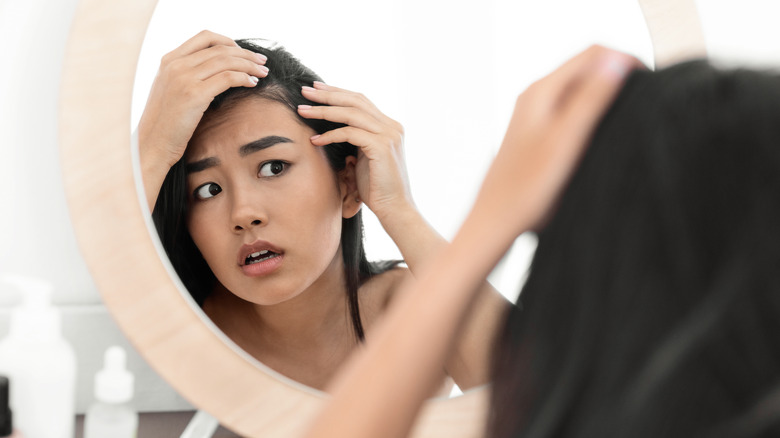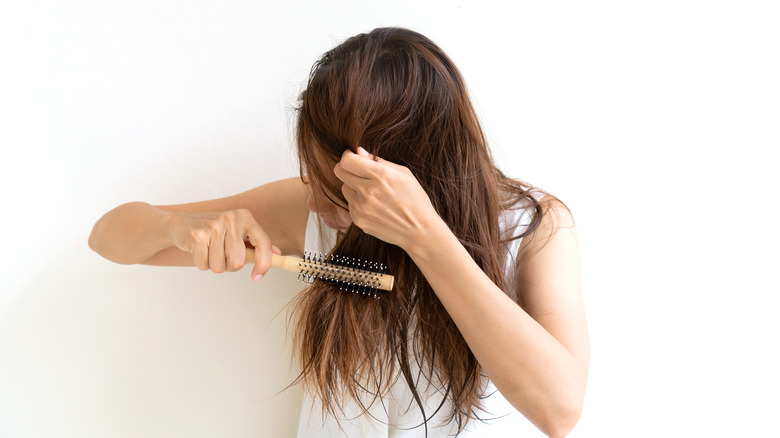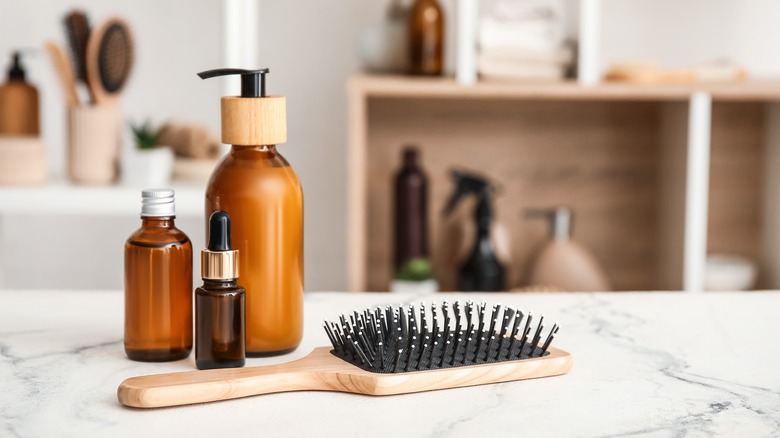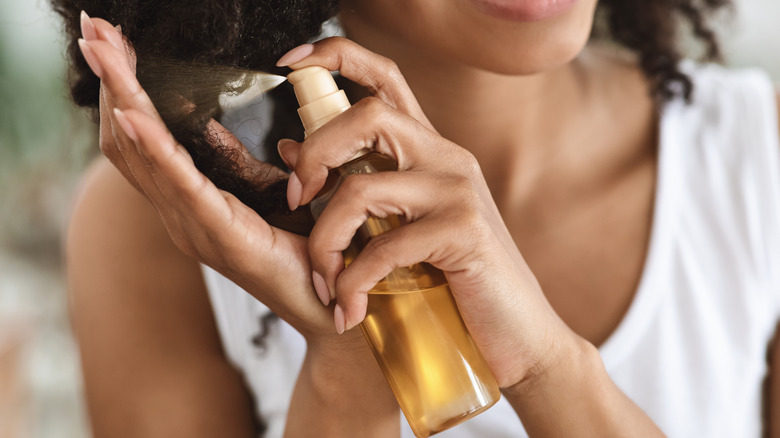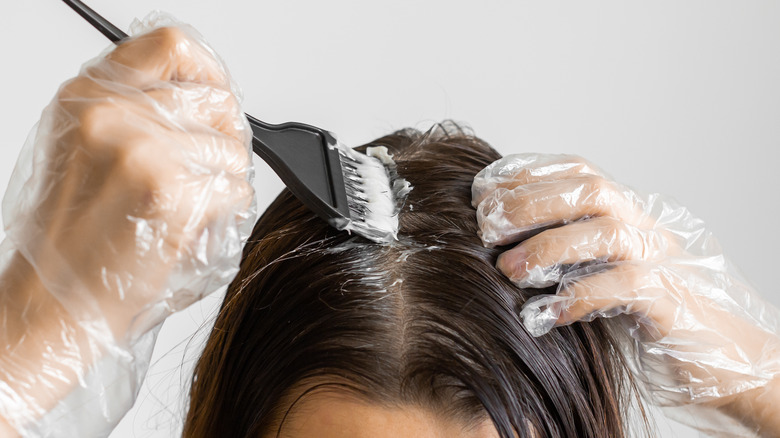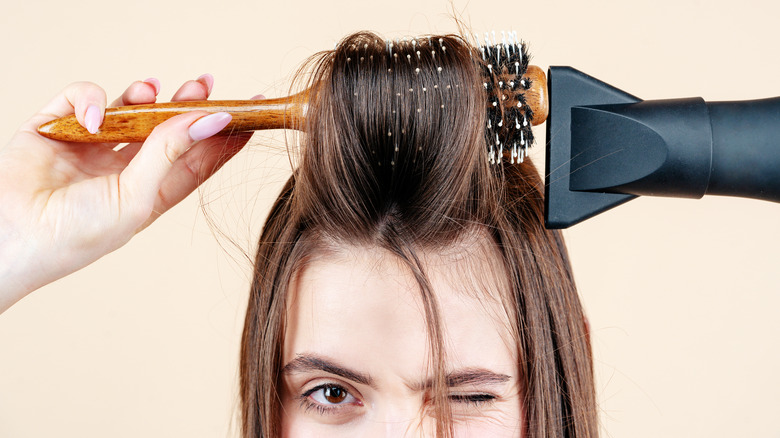Mistakes To Avoid If You Have Thin Hair
We may receive a commission on purchases made from links.
Having thin hair is not a fun ordeal. Typically thin hair comes with various rules to follow to get fuller-looking locks. Stylist partner Paul Rus tells Martha Stewart, "Density is always a differentiating factor—fine hair means the strand of hair is smaller in diameter, while thin hair means there's simply fewer strands of hair growing, no matter how thick." According to Rus, thin hair usually will make your hair appear less voluminous and show more of your scalp. Having thin hair can become frustrating when you aren't able to get fun hair looks that require thicker hair. Whether you were born with naturally thin hair or your hair started thinning out of the blue, there's some essential information to know to properly care for your hair.
While most people with thin hair know about using volumizing products and certain techniques, there's always a handful of mistakes made. These mistakes are not only not making your hair look its best, but can be actively weighing it down to the point where it loses any volume or shape. Although it can be challenging to stop thin hair, it's easy to correct these mistakes and get the hair you want.
Brushing wet hair
When trying to maintain your thin hair, you want to remember that it is very sensitive and fragile. Overall, thin hair is the weakest of all hair types and is prone to breakage and damage. Add to this that hair is the most susceptible to breakage when it's wet and you could have real issues when it comes to handling your hair when wet. Hair Club states that when your hair is wet, the last thing you want to do is to vigorously brush your hair with a typical bristle brush. That kind of hairbrush is too rough for wet, thin hair and ultimately will break the hair. Hair Club recommends using a wide-tooth comb instead and running it through as gently as possible.
Spornette adds that wet hair brushing should be done very carefully as the molecules that hold together the hair cuticles become more fragile when wet. If you want to prevent any breakage, Spornette recommends waiting until your hair is at least partially dry before running it through a comb.
Using a heavy shampoo and conditioner
As we've established, one of the first places you want to ensure that you are taking care of thin hair is while in the shower. Using the correct shampoo and conditioner is vital in making sure that your hair is not weighed down or lays flat for the rest of the day. Unfortunately, many will go with a typical product pick and not pay attention to the specifics of the products they are using. As hairstylist and founder of Percy & Reed Paul Percival tells Who What Wear, "You need to make sure you are using the right shampoo, and in particular, the right conditioner that's not heavy. If you use something that weighs the hair down, you've got an uphill battle from the start."
When picking out your next shampoo and conditioner, you want to ensure that they contain descriptors that are helpful for thin hair. Ideally, you want thin-hair-specific products or words such as "volumizing" on the label. This minor detail lets you know the product is not created to weigh down the hair with overhydration. As an example of the type of product to look for, take a look at BondiBoost's Hair Thickening Therapy Shampoo and Hair Thickening Therapy Conditioner, both of which currently hold a 4.9 rating on Sephora. Both of these products are formulated to thicken and give a boost to limp hair, making them the perfect in-shower solution.
Using too many hair products
Another mistake most people with thin hair tend to make is putting too many haircare products into the hair. Although it's reasonable to believe that those with thin hair need to put on volumizing products to give an extra lift, adding too many products can do the complete opposite. Because thin hair is very sensitive to the number of products you put on, the more products you use, the heavier it makes your hair.
Connecticut-based dermatologist Dr. Mona Gohara tells PureWow, "Choose one or two products max that can help with hair health. Minimizing the number of chemicals that touch your hair and scalp will reduce the likelihood of irritation or inflammation, and prevent weighing down already thin hair." That is because when you have thin hair, you also want to consider that your scalp will be more visible than other hair types, meaning you need to consider its health as well.
Stylist Natasha Nasta echoes this advice by telling Vogue India, "Never use heavy moisturizing products on the crown area or anywhere close to your scalp." Nasta recommends instead using a root lifter only on your roots and avoiding any other product on your scalp. Instead, try to add any additional products from the midsection to the ends only. Since having thin hair can typically trigger other hair issues, you want to avoid putting too many of these chemicals into your scalp.
Choosing the wrong hair color
While taking care of your hair can come down to the products that you use, you also want to take into consideration your hair color. Unfortunately, one mistake that is often overlooked is choosing the right hair color for your hair type. Although this won't always align with the newest trending hair color, it's important to consider which color will help your hair look its best.
Hair Finder recommends avoiding any hair color that sharply contrasts with the color of your scalp. Because your scalp will be more noticeable with thin hair, you want to distract as much as possible from it to avoid having your hair look too thin. Instead, opt for a shade close to your scalp color, which gives the illusion of fuller hair.
Another mistake people tend to make is not asking for highlights and shadows when getting their hair dyed. These create more dimension and depth to your hair, making it look fuller. Bobby Mack, the owner of the Bobby Mack & Co Hair Studio, tells Southern Living, "For every light or dark piece of dimensional color, there must be a balance. That means incorporating depth with color shadowing and adding bolding brightness with highlights." Mack describes this process as the same concept as facial contouring, as in using lights and darks to create your desired look.
Regardless of what you choose, avoid using a single color all over, as this will give your hair a one-dimensional look.
Blow drying it the wrong way
Looking back at photographs of old Hollywood, it's hard to ignore the perfectly blow-dried hair that was always packed with volume to spare. When you have thin hair, it can be difficult to achieve this same look. What makes it more difficult is the fact that by following regular blow-drying techniques, you are hurting your hair even more. Brushing down your hair with a blow dryer will only produce flat hair, the opposite of what you want to achieve.
Rebecca McCann, the founder of Pro Blo, tells Glamour Magazine, "Blow-dry your hair on top of the brush, rather than underneath it to create more lift at the root." McCann adds that you want to lift your hair away from your head to create that extra lift. If you pull your hair down when blow drying, it will drag the hair down.
Sam Villa adds that because mousse adds texture and volume, it makes the perfect companion when blow drying. They recommend adding some mousse when your hair is about 80% dry to add even more volume before using your round brush.
